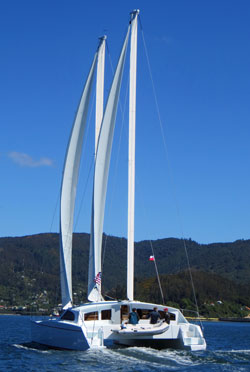MastFoil™
Is the MastFoil revolutionary? Yes, we think so.
 The new Atlantic 47 MastFoil Catamaran design continues to build on the Atlantic Cat series' innovative history with an exciting and entirely new sailing rig. The design goal was to develop the easiest to handle and safest sail plan possible for short handed cruising without sacrificing performance. That goal has been met. The patented Chris White Designs MastFoil™ is a unique combination of modern rigid airfoil technology with proven soft sails. The basic concept is not new and you can see examples of large rigid wings and soft sails in recent America's Cup catamarans.
The new Atlantic 47 MastFoil Catamaran design continues to build on the Atlantic Cat series' innovative history with an exciting and entirely new sailing rig. The design goal was to develop the easiest to handle and safest sail plan possible for short handed cruising without sacrificing performance. That goal has been met. The patented Chris White Designs MastFoil™ is a unique combination of modern rigid airfoil technology with proven soft sails. The basic concept is not new and you can see examples of large rigid wings and soft sails in recent America's Cup catamarans.
However the MastFoil has some important differences from all out racing rigs. The main difference is that the MastFoil is a small part of the overall sail plan and can rotate 360 degrees around the load bearing mast. This allows it to be feathered on any point of sail and in any wind velocity. Left alone, the foil will continuously feather if the control is set in that mode. Without this critical ability to feather on any heading, a rigid airfoil would not be suitable for use on a cruising boat. Another important difference is that the foil does not carry any of the mast compression loads. This enables the foil to be lightweight, structurally simple and to rotate easily around the mast.
Why eliminate the mainsail? Many sailors agree that the mainsail, particularly the large roached, full battened mainsail combined with the aft-led-shroud, no-backstay-configuration that is used in most catamarans today, is a troublesome sail to hoist, reef/unreef, furl and cover. In addition, mainsails create significant safety liabilities because they cannot be easily or quickly reefed or furled when sailing downwind. In violent squalls this feature has caused more than a few capsizes. The conventional catamaran mainsail can also be somewhat challenging to gybe in a blow.
Many sailors agree that the mainsail, particularly the large roached, full battened mainsail combined with the aft-led-shroud, no-backstay-configuration that is used in most catamarans today, is a troublesome sail to hoist, reef/unreef, furl and cover. In addition, mainsails create significant safety liabilities because they cannot be easily or quickly reefed or furled when sailing downwind. In violent squalls this feature has caused more than a few capsizes. The conventional catamaran mainsail can also be somewhat challenging to gybe in a blow.
For all the trouble associated with the mainsail, what do you get? Per unit of sail area, the mainsail is the least efficient sail on the boat. Sailing upwind, the mast - at the aerodynamically critical leading edge of the mainsail - robs a great deal of its power. Sailing downwind, the shrouds prevent easing the sheet enough to un-stall the sail. Also the large roach area of the sail contributes to significant weather helm which slows the boat and can make steering more difficult.
At the other extreme in sail handling is the modern roller furling jib. You don't need to hoist and drop the sail every time you use it. It reefs easily on any point of sail. It furls completely in seconds. Couple these attributes with a rugged self-tacking set up and you have a very easy to handle and highly efficient soft sail.
In the quest for simplified handling and improved safety, there's an obvious solution. Get rid of the mainsail. And in its place substitute more jib area combined with a super-efficient MastFoil™.
MastFoil Advantages:  -The soft sails can be reefed and furled on any point of sail and in any wind velocity. Anyone can safely handle this rig.
-The soft sails can be reefed and furled on any point of sail and in any wind velocity. Anyone can safely handle this rig.
-Simple and quick self-tacking.
-Super safe and effortless gybing.
-The MastFoils add considerable drive to the sail plan despite their modest size. In stronger winds the MastFoils alone will provide enough power to sail in any direction.
-The MastFoils are excellent storm sails. They create powerful drive, but minimal heeling forces because of their size and aspect ratio. The MastFoils are quiet, never flog, have very low "sheet" loads, and they can be trimmed for efficient operation in any wind direction.
-The MastFoils can be easily feathered into the wind on any point of sail which makes them nearly "invisible" to the wind.
-The MastFoils generate much less aerodynamic windage (drag) than conventional mast and rigging, which translates to less strain on the anchor, thereby reducing the risk of dragging. The MastFoil rig will reduce the wind drag at anchor by approximately 20%.
-The dramatically simplified mast and rigging improves reliability. A MastFoil mast has less than one quarter of the number of load bearing parts of a conventional mast. Fewer parts mean fewer possible points of failure and consequently less risk of mast failure.
-Extraordinary downwind performance. The MastFoil can be trimmed to avoid stall on any heading. In combination with soft sails, including any type of gennaker or spinnaker, the A47 is quite fast and easy to control downwind.
-Great upwind performance. Tests indicate the MastFoil will be at least equal to a standard catamaran rig sailing upwind.
-No anchor bridle required. Anyone who has owned a ketch knows how well behaved they are at anchor with a partial mizzen sheeted flat amidships. The A47 will do essentially the same with the aft MastFoil locked on center and the forward MastFoil allowed to rotate.
FAQs:
Why does the A47 have two masts?
While the MastFoil rig could have any number of masts it seemed that the two mast ketch configuration offered the best solution. Also having two MastFoils and two jibs offers more options for sail trim and balance, particularly when under MastFoil alone. Beyond that, split rigs have numerous advantages for cruising. Complete redundancy is very nice to have if you are thousands of miles from nowhere. And ketches are always fast downwind.
Can I use a bowsprit and roller furling downwind sails with a MastFoil rig?
Yes. There are no constraints dictated by the mast.
What is the mast made of?
The mast is carbon fiber/epoxy for maximun stiffness and strength.
Is the MastFoil difficult to trim?
No. The forces required to turn the foil are low. The angle it should be trimmed to the apparent wind can be determined by watching the streaming action of normal tell tales placed on the foil. However, the nature of a rigid foil with a rounded leading edge is that it has a wide range of trimming angles that work, so trim is not particularly sensitive.
What happens with the MastFoil when the boat is on the dock?
Because the MastFoil can rotate freely (when the control line is released) the foils will automatically feather themselves into the wind, thus causing negligible drag and lift.
What happens with the MastFoil rig offshore in a storm?
Nothing, if that is what you want! The foil will feather into the wind on any point of sail. When feathered, the drag of the mast and rigging is reduced by about 90% over a conventional mast. In severe weather having the least windage possible will make handling the boat safer and easier.
Is the mast rotating?
No. The MastFoil mast is a very simple non-rotating mast. This avoids the numerous problems associated with rotating masts such as unfair halyard exit leads, corrupted masthead instruments and lights, inability to adequately tension the shrouds, etc.
How is the mast stayed?
In the A47 each mast has a very robust headstay and two shrouds. There are no spreaders, diamonds, lower shrouds or running backstays.
If the foil were to break would it compromise the mast itself?
No. The mast function is separate from the foil. The foil could be removed and the mast would still behave structurally as it did before.
Is the MastFoil rig exclusive to Chris White Designs?
Yes.
Is the MastFoil patented?
Yes. MastFoil™ is covered by Patent# 8919272 and Patent# 9114863.
What if I want a standard rig on an Atlantic 47?
Sure, if you prefer a conventional rig that can be done. There are some structural changes required to suit the rig and deck hardware but the interior stays basically the same for either rig.
Why do you think this is such a big deal?
-The MastFoil rig solves many sail handling problems faced by cruising sailors. Because its so easy to reef and un-reef, cruising sailors will be more likely to do so frequently rather than toughing out a squall or waiting for the lull to pass. And being able to easily carry the appropriate amount of sail has obvious safety and performance advantages. Cruisers, even when sailing shorthanded, have the chance for higher daily average speeds, and greater comfort and safety.
-When struck by a violent wind gust, whether from a squall or topography, the MastFoil rig can be quickly and completely depowered by easing the sheets. There is nothing in the way to prevent the sails and foils from luffing, even when deep reaching. Try reefing or even dropping a conventional mainsail with 50 kts of wind behind the beam. It can't be done, at least not quickly. That is not particularly safe and has contributed to numerous sailing accidents.
-In strong weather the foils provide most or all of the necessary drive and they do it so easily. There are extremely low heeling forces, extremely low loads on the "sheet" and low loads in the mast when the fabric sails are furled.
-The foils can be gybed conventionally which is quick and easy, and they can also be gybed around the front of the mast, which in severe conditions will eliminate a lot of stress, both mental and physical.
Other Benefits
Beyond all of the obvious beneficial MastFoil features there are a number of handling advantages that have yet to be explored in detail.
-Pinned to the dock by a 30 knot wind? We think that by trimming the MastFoils correctly, enough sideways lift can be created to actually pull the boat away from the dock! Try doing that with a conventional rig. Note that the apparent wind angles (AWA) will likely need to be outside of 70-110° for this to work.
-Using the foils to combat a crosswind when trying to get into a slip? That should only be a matter of trimming correctly and balancing the fore and aft forces with the engine to create enough side force to neutralize the crosswind.
-Sailing in reverse? Easy, just trim the foils in the right direction.
-If you are running off in a storm the MastFoil can function as an "air drogue" by providing stern-ward thrust to offset the windage of the hulls and deckhouse. This should be possible with AWA forward of 155° and 205°.
-Heaving to offshore? With proper trim the MastFoil rig should be able to essentially stop (or slow) the boat regardless of its heading (except dead to windward of course).
All together the MastFoil rig offers an incredible combination of desirable features. We think it is the shape of things to come.
MastFoil™ (Patent# 8919272, Patent# 9114863)


